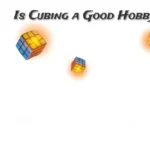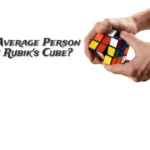One iconic image often comes to mind when you think of challenging puzzles: the Rubik’s Cube. Its colorful and twisting facets have bewildered, frustrated, and fascinated millions around the world. Yet, there’s a common misconception that solving the Rubik’s Cube is a feat reserved for geniuses or savants. In reality, this couldn’t be farther from the truth. The Rubik’s Cube can be solved by the average person with patience, practice, and the right approach. In this article, we’ll explore the journey of an average person learning to conquer this seemingly insurmountable puzzle.
A Brief History of the Rubik’s Cube
Before we explore the intricacies of solving the Rubik’s Cube, let’s take a moment to appreciate its history and the impact it has had on popular culture. The cube was invented in 1974 by Ernő Rubik, a Hungarian professor of architecture, as a teaching tool to help his students understand three-dimensional geometry. Originally, it was called the “Magic Cube.”
In 1975, the puzzle was patented, and a year later, it was licensed to the Ideal Toy Corporation and renamed the “Rubik’s Cube.” The puzzle made its international debut in 1980 and quickly gained popularity worldwide. Its colorful stickers, twisting mechanisms, and complex design fascinated people of all ages, leading to a craze that swept the globe.
Ernő Rubik’s creation became a symbol of intellectual challenge and problem-solving. While it initially seemed like an impossible task to solve, this was far from the case. The Rubik’s Cube wasn’t just a perplexing enigma; it was a cleverly designed mechanical puzzle with a specific set of rules and patterns that, when understood, made it solvable for anyone.
The Structure of the Rubik’s Cube
At its core, the Rubik’s Cube is composed of three major components: the centerpieces, edges, and corners. Understanding these elements is fundamental to grasping the mechanics of the cube.
1. Centerpieces: These are the static parts of each face of the cube. They don’t move and act as reference points for the rest of the cube.
2. Edges: These pieces contain two colors and are positioned between two centerpieces. Edges can be flipped but not rotated.
3. Corners: Corner pieces are situated at the intersections of three edges and can be twisted and flipped in place.
Each face of the Rubik’s Cube is composed of nine smaller squares, making for a total of 54 individual stickers or colored squares. The goal is to return each face to a single color. While this might sound daunting, the Rubik’s Cube is not as inscrutable as it appears.
Can the Average Person Solve the Rubik’s Cube?
Solving the Rubik’s Cube may seem like a daunting task, especially when considering the complex algorithms involved in the CFOP method. However, it’s crucial to dispel the myth that this puzzle is beyond the average person’s reach. In reality, anyone can conquer the Rubik’s Cube with the right approach and a willingness to learn.
The Rubik’s Cube is not a test of innate intelligence but rather a test of patience and determination. It rewards those who are persistent and willing to put in the effort to understand its mechanics. Whether you’re a child, a teenager, an adult, or a senior, the Rubik’s Cube is an attainable challenge.
The misconception that it’s only for the exceptionally gifted arises from its mysterious and seemingly chaotic appearance. Yet, beneath the surface, the cube follows a strict set of rules and patterns. These patterns are the key to unlocking the solution. With practice, you’ll recognize and exploit these patterns to solve the puzzle efficiently.
How to Average Person Learn to Solve the Rubik’s Cube?
Learning to solve the Rubik’s Cube is a journey that requires practice, perseverance, and the right resources. Here are some essential steps for beginners:
1. Gather Resources:
- Acquire a Rubik’s Cube. You can find them in various sizes and designs, but starting with the standard 3×3 cube is best.
- Use online resources such as video tutorials, mobile apps, and written guides. There are plenty of materials available for free to help you get started.
2. Understand the Basics:
- Learn about the cube’s components, as discussed earlier: centerpieces, edges, and corners.
- Familiarize yourself with the notation used to describe the cube’s movements, such as R (right), U (up), L (left), etc.
3. Practice Algorithms:
- For the beginner’s method, start with the initial steps: solving the white cross and the first layer.
- Memorize the algorithms for the middle and final layers (OLL and PLL).
4. Develop Intuition:
- As you practice, you’ll start to develop an intuitive sense of how the cube behaves. This intuition will help you identify patterns and anticipate moves more efficiently.
5. Be Patient:
- Understand that solving the Rubik’s Cube will not happen overnight. Building muscle memory for the various algorithms and refining your solving skills takes time.
6. Set Goals:
- Track your progress and set achievable goals. This will keep you motivated and help you see the tangible results of your efforts.
7. Join a Community:
- Consider joining online forums or local cubing groups. Sharing your progress and seeking advice from experienced cubers can be incredibly helpful.
Benefits of Solving the Rubik’s Cube
Solving the Rubik’s Cube offers a wide range of benefits far beyond the sheer satisfaction of completing the puzzle. Here are some of the advantages:
1. Cognitive Benefits:
- Improved Spatial Reasoning: Solving the Rubik’s Cube enhances spatial awareness and problem-solving skills. It encourages you to think in three dimensions.
- Enhanced Memory: Memorizing algorithms and recognizing patterns can improve your memory and cognitive flexibility.
2. Social and Recreational Aspects:
- Social Bonding: Cubing can be a shared hobby that connects you with others who enjoy the puzzle.
- Recreational Activity: It’s a fun and challenging pastime, perfect for relaxation and stress relief.
3. Personal Achievement:
- Mastering the Rubik’s Cube can be a symbol of personal accomplishment. It demonstrates your ability to tackle complex challenges with determination.
Overcoming Challenges
As with any new skill, learning to solve the Rubik’s Cube comes with its fair share of challenges and frustrations. Here are some common difficulties you might encounter and strategies for overcoming them:
1. Algorithm Memorization:
- Challenge: Memorizing the many algorithms needed to solve the cube can be overwhelming.
- Strategy: Break down the algorithms into smaller sets and practice them in isolation. Over time, they will become second nature.
2. Speed:
- Challenge: Speedcubing can be a goal for many, and achieving faster times requires precision and efficiency.
- Strategy: Practice solving the cube repeatedly, focusing on reducing your solving time. Experiment with finger tricks to make your movements smoother.
3. Plateaus:
- Challenge: You may reach a point where your progress stalls, and you’re unable to solve the cube any faster.
- Strategy: Analyze your solving techniques and look for areas of improvement. Consult with experienced cubers for advice on breaking through plateaus.
4. Frustration:
- Challenge: The Rubik’s Cube can be frustrating, especially when you encounter setbacks.
- Strategy: Maintain a patient and positive attitude. Take breaks when needed, and remember that every cuber faces challenges.
Conclusion
In conclusion, the Rubik’s Cube is not the insurmountable enigma it appears to be. While it may take time, effort, and determination, anyone can learn to solve it regardless of age or background. The key is to start with the right approach, whether that’s the beginner’s method or the more advanced CFOP method. Understand that the Rubik’s Cube is a puzzle designed with rules and patterns, and with practice, those patterns become clear.
The journey of learning to solve the Rubik’s Cube is not just about the destination but the experience itself. It’s about the cognitive benefits, the satisfaction of personal achievement, and the joy of sharing this unique hobby with others. So, if you’ve ever looked at a scrambled Rubik’s Cube and thought, “I could never do that,” think again. You, the average person, absolutely can. All it takes is the first twist, the first algorithm, and the first step on this rewarding and exciting puzzle-solving journey. Happy cubing!




